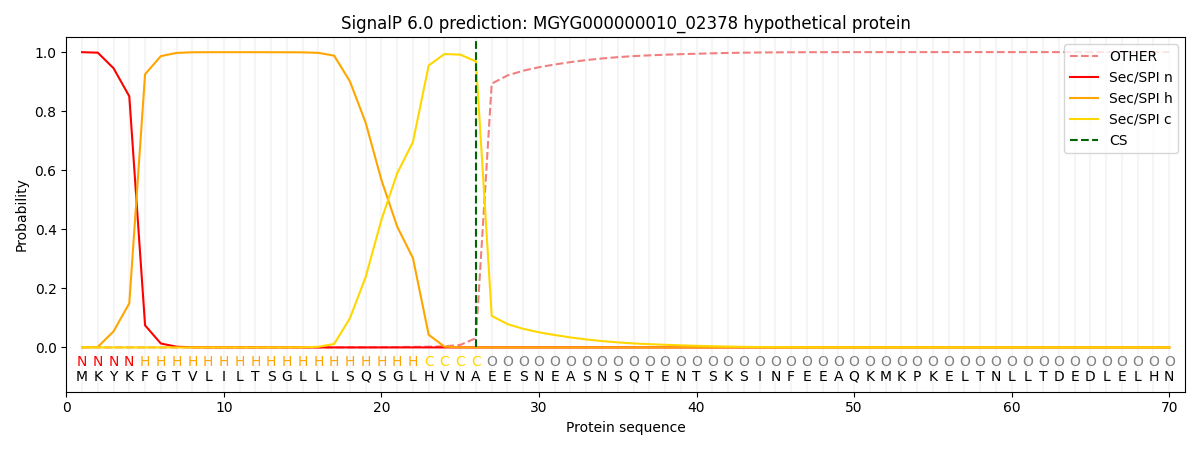You are browsing environment: HUMAN GUT
CAZyme Information: MGYG000000010_02378
You are here: Home > Sequence: MGYG000000010_02378
Basic Information |
Genomic context |
Full Sequence |
Enzyme annotations |
CAZy signature domains |
CDD domains |
CAZyme hits |
PDB hits |
Swiss-Prot hits |
SignalP and Lipop annotations |
TMHMM annotations
Basic Information help
| Species | Staphylococcus_A lentus | |||||||||||
|---|---|---|---|---|---|---|---|---|---|---|---|---|
| Lineage | Bacteria; Firmicutes; Bacilli; Staphylococcales; Staphylococcaceae; Staphylococcus_A; Staphylococcus_A lentus | |||||||||||
| CAZyme ID | MGYG000000010_02378 | |||||||||||
| CAZy Family | CBM50 | |||||||||||
| CAZyme Description | hypothetical protein | |||||||||||
| CAZyme Property |
|
|||||||||||
| Genome Property |
|
|||||||||||
| Gene Location | Start: 35751; End: 36755 Strand: - | |||||||||||
CDD Domains download full data without filtering help
| Cdd ID | Domain | E-Value | qStart | qEnd | sStart | sEnd | Domain Description |
|---|---|---|---|---|---|---|---|
| smart00644 | Ami_2 | 1.23e-20 | 128 | 253 | 5 | 126 | Ami_2 domain. |
| cd06583 | PGRP | 1.80e-17 | 128 | 256 | 4 | 126 | Peptidoglycan recognition proteins (PGRPs) are pattern recognition receptors that bind, and in certain cases, hydrolyze peptidoglycans (PGNs) of bacterial cell walls. PGRPs have been divided into three classes: short PGRPs (PGRP-S), that are small (20 kDa) extracellular proteins; intermediate PGRPs (PGRP-I) that are 40-45 kDa and are predicted to be transmembrane proteins; and long PGRPs (PGRP-L), up to 90 kDa, which may be either intracellular or transmembrane. Several structures of PGRPs are known in insects and mammals, some bound with substrates like Muramyl Tripeptide (MTP) or Tracheal Cytotoxin (TCT). The substrate binding site is conserved in PGRP-LCx, PGRP-LE, and PGRP-Ialpha proteins. This family includes Zn-dependent N-Acetylmuramoyl-L-alanine Amidase, EC:3.5.1.28. This enzyme cleaves the amide bond between N-acetylmuramoyl and L-amino acids, preferentially D-lactyl-L-Ala, in bacterial cell walls. The structure for the bacteriophage T7 lysozyme shows that two of the conserved histidines and a cysteine are zinc binding residues. Site-directed mutagenesis of T7 lysozyme indicates that two conserved residues, a Tyr and a Lys, are important for amidase activity. |
| COG5632 | CwlA | 3.82e-16 | 90 | 262 | 2 | 152 | N-acetylmuramoyl-L-alanine amidase CwlA [Cell wall/membrane/envelope biogenesis]. |
| pfam01476 | LysM | 5.33e-13 | 292 | 334 | 1 | 43 | LysM domain. The LysM (lysin motif) domain is about 40 residues long. It is found in a variety of enzymes involved in bacterial cell wall degradation. This domain may have a general peptidoglycan binding function. The structure of this domain is known. |
| cd00118 | LysM | 1.76e-11 | 291 | 333 | 2 | 45 | Lysin Motif is a small domain involved in binding peptidoglycan. LysM, a small globular domain with approximately 40 amino acids, is a widespread protein module involved in binding peptidoglycan in bacteria and chitin in eukaryotes. The domain was originally identified in enzymes that degrade bacterial cell walls, but proteins involved in many other biological functions also contain this domain. It has been reported that the LysM domain functions as a signal for specific plant-bacteria recognition in bacterial pathogenesis. Many of these enzymes are modular and are composed of catalytic units linked to one or several repeats of LysM domains. LysM domains are found in bacteria and eukaryotes. |
CAZyme Hits help
| Hit ID | E-Value | Query Start | Query End | Hit Start | Hit End |
|---|---|---|---|---|---|
| QMU10403.1 | 3.06e-237 | 1 | 334 | 1 | 334 |
| QQY19081.1 | 6.77e-194 | 1 | 334 | 1 | 329 |
| QQT15619.1 | 6.77e-194 | 1 | 334 | 1 | 329 |
| QTN10380.1 | 1.12e-192 | 1 | 334 | 1 | 329 |
| QRO85446.1 | 1.12e-192 | 1 | 334 | 1 | 329 |
PDB Hits download full data without filtering help
| Hit ID | E-Value | Query Start | Query End | Hit Start | Hit End | Description |
|---|---|---|---|---|---|---|
| 4KNK_A | 5.09e-46 | 93 | 275 | 29 | 211 | ChainA, Bifunctional autolysin [Staphylococcus aureus subsp. aureus NCTC 8325],4KNK_B Chain B, Bifunctional autolysin [Staphylococcus aureus subsp. aureus NCTC 8325],4KNL_A Chain A, Bifunctional autolysin [Staphylococcus aureus subsp. aureus NCTC 8325],4KNL_B Chain B, Bifunctional autolysin [Staphylococcus aureus subsp. aureus NCTC 8325],4KNL_C Chain C, Bifunctional autolysin [Staphylococcus aureus subsp. aureus NCTC 8325],4KNL_D Chain D, Bifunctional autolysin [Staphylococcus aureus subsp. aureus NCTC 8325] |
| 3LAT_A | 1.21e-43 | 84 | 275 | 11 | 202 | Crystalstructure of Staphylococcus peptidoglycan hydrolase AmiE [Staphylococcus epidermidis],3LAT_B Crystal structure of Staphylococcus peptidoglycan hydrolase AmiE [Staphylococcus epidermidis] |
Swiss-Prot Hits download full data without filtering help
| Hit ID | E-Value | Query Start | Query End | Hit Start | Hit End | Description |
|---|---|---|---|---|---|---|
| O33983 | 5.03e-44 | 90 | 275 | 82 | 267 | Protein Ami OS=Listeria monocytogenes serotype 1/2a (strain EGD / Mackaness) OX=1334565 GN=ami PE=3 SV=1 |
| Q99V41 | 7.99e-42 | 93 | 275 | 217 | 399 | Bifunctional autolysin OS=Staphylococcus aureus (strain N315) OX=158879 GN=atl PE=1 SV=1 |
| Q931U5 | 7.99e-42 | 93 | 275 | 217 | 399 | Bifunctional autolysin OS=Staphylococcus aureus (strain Mu50 / ATCC 700699) OX=158878 GN=atl PE=1 SV=2 |
| Q6GAG0 | 8.00e-42 | 93 | 275 | 225 | 407 | Bifunctional autolysin OS=Staphylococcus aureus (strain MSSA476) OX=282459 GN=atl PE=3 SV=1 |
| A7X0T9 | 8.01e-42 | 93 | 275 | 224 | 406 | Bifunctional autolysin OS=Staphylococcus aureus (strain Mu3 / ATCC 700698) OX=418127 GN=atl PE=3 SV=2 |
SignalP and Lipop Annotations help
This protein is predicted as SP

| Other | SP_Sec_SPI | LIPO_Sec_SPII | TAT_Tat_SPI | TATLIP_Sec_SPII | PILIN_Sec_SPIII |
|---|---|---|---|---|---|
| 0.000411 | 0.998538 | 0.000557 | 0.000183 | 0.000157 | 0.000142 |
